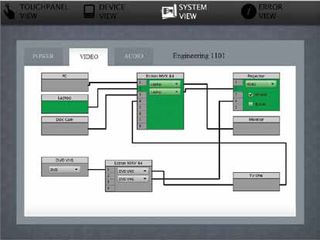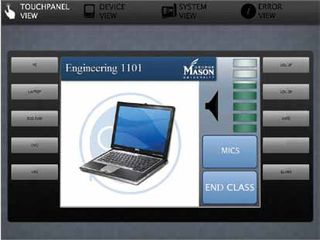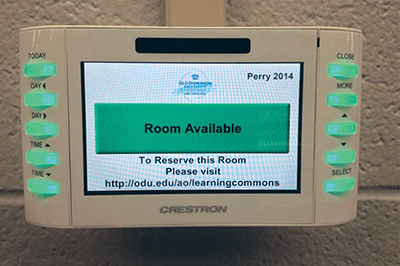At Old Dominion University, the Classroom Central staff
has integrated AV control systems with Open Room, an
open-source room-reservation web application in their
Learning Commons. Technology managers have long utilized audiovisual control systems as the replacement for remote controls in their facilities. These integrated systems provide a simplified user experience that allows the end user to execute complex routines with the touch of a button or touchpanel. In recent years, control systems have made great strides in providing increased amounts of functionality and are poised to provide even move with coming improvements.
A new set of tools
Historically, AV control systems are programmed using manufacturer proprietary programming language. Recently, Crestron has announced their Series 3 processors, which support Core3OS and Core3UI. Soon Crestron programmers will have access to the C# programming language, which will provide programmers with the ability to have native connections to databases from within their control system, parse XML and HTML data sources, and have active directory integration. AMX has allowed programmers to utilize a standard IT programming language for some time now, as Java has been supported for module development since 2004.
“These additional tools allow us to create solutions that our clients have been asking for,” explained Steve Greenblatt, president of Control Concepts Inc., an audiovisual control system solutions provider. “The customer is changing. They are familiar with technology and no longer need to be introduced to the concept of what a control system can do. The user wants an experience that can mirror mainstream devices of the day.” Greenblatt stressed that “programmers and technologists will need to be patient as functionality is rolled [out].”
Interfacing with more than the AV systems
A growing trend in control systems is that they integrate with other IT systems. This can be building systems, information systems, or internet-based application. At Old Dominion University, the Classroom Central staff has integrated AV control systems with Open Room, an open-source room-reservation web application in their Learning Commons. “At this point, students can see if a room is reserved and who has reserved it via a touchpanel on each study room,” explained Dwayne Smith, the Classroom Central senior engineer with Old Dominion University. He further explained that the integration has limitations, as it only pulls data from the information system. “When the tools become available to directly connect to SQL databases, I see extending the functionality to allow students to make reservations directly from the touchpanels. AV systems are coming late to the party; IT systems have been using common languages and protocols to provide integration for many years.”


As Dwayne Smith, the Classroom Central senior engineer with Old Dominion University, explained, “AV systems are coming late to the party; IT systems have been using common languages and protocols to provide integration for many years.” George Mason University’s AV programmers utilized Crestron’s programming tools and control processes to create computerbased interfaces to specific diagnostic tools for each of the university’s standard designs (pictured above). Smith also sees the day when control systems take a larger role in unified communications. “I would like to see an environment where a user can walk into a room and start a web conference from a touchpanel with a single button press.”
Rethinking the control system
As technology managers start new projects, they should begin to rethink what their AV control system entails. While the common elements of source and transport control should be maintained, technology managers should begin to explore how they can make the control system the center of the user experience within a facility. Control systems can now be tied into building systems such as lighting, environmental systems, and security. Information systems such as scheduling, directories, and content management systems can be integrated as well to bring additional functionality into the system. Technology managers can simplify the user experience by providing a single point of interface in their facility with these diverse systems.
Another way that technology managers can rethink the control system is by developing a common control system program to support multiple technology configurations. Technology managers can develop a consistent system design that may have variation with sources or displays. Rather than needing to reprogram the system each time a component is changed, the program can be designed so that either configuration data is loaded from a file on the system or the system is configured via an administrative menu. This will allow technology mangers to swap projectors or DVD players within a system with minimal expense and allow faster restoration of service.
Directory services and user accounts are another way that technology managers can look to enhance their users’ experience. Authentication can prevent unauthorized users, and if user accounts are tied to system configurations, users can have a customized interface loaded for them upon log-in. Additionally, as technologies such as near field communication (NFC) mature, users can authenticate with their mobile devices based on proximate the control system.
Training for the future
As control systems change, organizations that do their own programming must keep up with the industry trends and maintain their training. Technology managers should be talking with their control system manufacturers to develop a learning path for their staff. This will include learning new programming languages, enhancing network skills, and becoming more familiar with the IT development environment and processes. Additionally, technology managers should consider the other IT systems that they will integrate with and determine if there are additional programming languages or web development skills required to integrate those systems.
The recent advancements in control systems provide a great opportunity for technology managers to improve their user environment and bring more systems under a single interface. With proper planning, this can be used to improve the user experience.
Leveraging control systems to create an enterprise support environment
When George Mason University first began deploying digital systems in 2010, it became apparent that a new set of tools would be required to provide the support staff with the information needed in real time to support the faculty and students. Our AV programmers utilized Crestron’s programming tools and control processes to create computer-based interfaces to specific diagnostic tools for each of the university’s standard designs. (The Xpanels, distributed both on a shared network drive and via an intranet, provide device status, routing, HDCP, EDID, and resolution data to any support staff member at any campus over the network.) After the development initiative, GMU’s programmers began developing Flash-based supported tools using Crestron’s Flash SDK to provide similar tools for systems in a webbased environment. With these tools George Mason is able to help the faculty and students in real time and resolve many calls over the phone rather than sending a technician to the classroom.
Matthew Silverman, CTS, PMP, is a project manager with the division of instructional technology at George Mason University in Fairfax, Virginia. He is an active member of InfoComm, serving on the standards committee and the technology managers council. He is a regular contributor to the AVNation EDtech podcast. Reach him at matt@nextedutech.com or follow him on Twitter at @msilverm.










